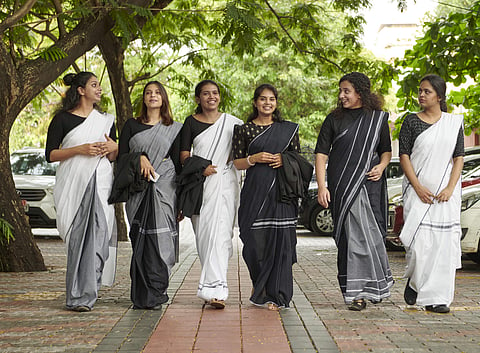

May 4 marked the 115th birthday of Anna Chandy, the first female justice in India. To celebrate this, Save The Loom — a nonprofit community that has been working to revive, restore, and restructure the handloom industry in India since 2019 — launched Vidhi. The latest collection offers a fashionable and comfortable twist to the dress code that female lawyers are required to adhere to in court. These handloom sarees are woven by traditional craftsmen whose livelihood has been threatened by consecutive disasters. We speak to the founder Ramesh Menon about the initiative that has been slowly creating waves with its modern touch. Excerpts:
1. What made Save The Loom steer towards this line of weaving?
Soon after the 2019 floods, when we started Save the Loom, the lawyer fraternity had volunteered to help us. In October 2020, Justice KK Usha, one of our founding patrons and the first female Chief Justice in the Kerala High Court, passed away. That was the starting point of the idea behind Vidhi. In a bid to honour the great woman she was, we looked for something that would give consistent work for our weavers. The work they regularly do largely caters to festivals and these consecutive years of floods and two waves of the pandemic have wreaked havoc on their livelihood. They don’t have regular work now and the wages are low. Unless they can be utilised to do something far more productive, it would be problematic. Through this collection, we could address that.
2. How would you describe the collection?
We are trying to bring in a change of perspective in this area of clothing where there is a restricted colour code. Black and white, generally. In terms of design, surface designs would not have worked for this. We realised that handwoven textiles could give us the bandwidth to solve this issue as opposed to machine-made textiles. This material, by default of its nature, has far more breathability. Since we use finer cotton and a certain form of weaving, we are also able to ensure that these sarees will be comfortable and stylish.
3. Why did you feel that a reinvention of legal attire was necessary?
Law is one profession where most people spend 13 to 14 hours at work. Most courts in India are still not air-conditioned and are not properly ventilated. And lawyers have to wear these multiple layers of clothing, irrespective of what the climatic conditions are in the area. We also collaborated with lawyers to research how best we could solve the problem of the existing design. When we say design, it also gave us space to communicate the fact that design is not always purchase-related. At the textile level, we could bring in a lot of improvements. Our research also led us to the discovery that the first female justice in India came from Kerala. Anna Chandy was the first woman to practice law. At the time, women couldn't practice even if they had a degree. The legacies of these women are connected and in sync with the stories we were trying to build.
4. How have the weavers been impacted so far?
Usually, designers say that weavers have ‘something to contribute’ and they ‘have some skill to offer’. We looked at it from another perspective. Weavers are far more skilled than any designer in the country because they have inherited their skill sets from their forefathers and not through any formal education. It’s a highly skilled job that has been translated through generations. All sorts of experiments have happened through that space. Largely, weavers today are past their prime. Most of them are over the age of 45. It is not a sustainable livelihood anymore, they get paid by the piece. Through this collection, we have been working towards paying them standardised wages.
5. How has the collection been received?
People have different ideas of what fashion means to them. So we went back to the drawing board. That was far more productive for us. Senior judges and lawyers are used to wearing sarees. They are very clear about it, but the younger generation does not adhere to this norm as much. So for us to get them into the fold, it was also important to offer more modern options as well. We have received amazing feedback through our trial runs. Once they tried them on, they realised how comfortable it was. Younger lawyers spend more hours at work. So for them, comfort and fashion are equally important. We’ve taken all of this into account with Vidhi.
